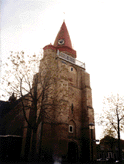 OUDDORP
OUDDORP  OUDDORP
OUDDORP
STARTING FROM 300 YEARS BC
The First Inhabitants

The island of Westvoorne (now called Goeree) is the oldest part of the now combined two islands, Goeree and Overflakkee. (See 'Maps'). Based on the analyses of broken pottery found during excavations in the year 1995, near Ouddorp, one can be safe in presuming that the Ouddorp area already had inhabitants during 350-200 BC. During excavations prior to the one in 1995, on other parts of Goeree, Roman pottery had already been discovered.
In many ahnentafels with persons who were born in Ouddorp, you often read: born in Oudeland (near Ouddorp). Oudeland refers to the oldest polder 'Oudeland van Diepenhorst', in which Ouddorp is situated. This polder probably came into existence in the 7th century. The excavations in this polder found broken pottery of the Merovingian period (430-750).
Other parts of Westvoorne were Oude-Nieuwland, West-Nieuwland and Oude Oostdijk.
Ouddorp Church - Photo by René Luijkenaar
Late Medieval Impoldering
As you can see on the map, dated ca 1300, the 'island' of Flakkee only consisted of a larger island 'Dirksland' and lots of muddy sand-banks. During very high tide the sand-banks inundated (partially) and the inhabitants needed shelter on self-made hills. Remainings of houses, built prior to the impoldering, were found near Ooltgensplaat. Even today the Dutch are famous for impoldering, building dikes and all kinds of water control. Our present prince royal, Willem Alexander, even has a function in the water management. Water management, and special concerning the North Sea and the river Rhine, is very important, as a big part, and the most populated area of our country, is below sea level!
The first polder of what later was called 'Flakkee,' was Dirksland (1415), probably named after Diderick (=Dirk) van Zierikzee. Soon thereafter Herkingen followed. Most of the impoldering was completed before the end of the 15th century.
Struggle Against The Sea
That does not mean that dikes always were safe. Many times the dikes busted. Most of us still remember the floods of February 1, 1953, whereby 1835 persons and tens of thousands of cattle were drowned, over 4500 buildings completely destroyed and over 50,000 houses damaged. Over 100,000 people, including my wife (then a child), had to be evacuated. As a consequence of this disaster I joined the Red Cross Voluntary Corps. (See: About me). But there were other floods too, like All-Saints-Floods in 1570 whereby parts of the provinces of Groningen, Friesland, Noord-Holland and all of the islands of Zuid-Holland and Zeeland were inundated. And again in 1682 there were 28 polders inundated. The slogan for the province of Zeeland has a bearing upon this matter: 'I struggle (against the sea) and float above the sea.'
Means Of Subsistence
Goedereede (= good roadstead), together with Ouddorp (=old village), became important places on this island. In 1312 Goedereede, with it's merchant ships going to England (to export fish and to import wool) received certain privileges. At the end of the 16th the prosperity of Goedereede ended, due the silting-up of their seaport, the basis of Goedereede's wealth. The ships had to go to Middelharnis, and that village became important, as did the nearby village of Sommelsdijk. In 1486 Sommelsdijk, at that moment an enclave of Zeeland (until 1805) on the island of Flakkee, belonging to the county of Holland, received the privilege to hold a weekly market. Due to all the surrounding waters, many people had occupations in fishery and shipping, but most were engaged in farming, as all of you having ancestors on Goeree-Overflakkee know.
I hope you found this story interesting and I am always willing to give you further information. Come and visit these 'Low Lands.'
 Leo Akershoek
Leo Akershoek
My hobby?
Digging-up dead relatives!

Return to HOME
Webpage design by jcjens
Copyright©1999